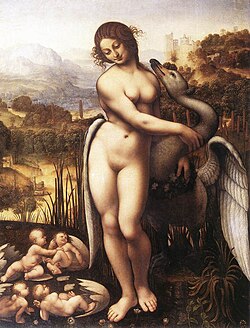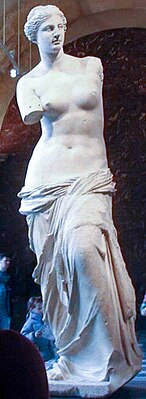Contrapposto
Contrapposto is an Italian term that means counterpose. It is used in the visual arts to describe a human figure standing with most of its weight on one foot so that its shoulders and arms twist off-axis from the hips and legs. This gives the figure a more dynamic, or alternatively relaxed appearance. It can also be used to refer to multiple figures which are in counter-pose (or opposite pose) to one another. It can further encompass the tension as a figure changes from resting on a given leg to walking or running upon it (so-called ponderation). Contrapposto is less emphasized than the more sinuous S Curve.
- Examples of contrapposto
-
David, by Michelangelo. The shoulders of the figure are seen to angle in one direction, the pelvis in another.
-
A marble copy of the Doryphoros of Polyclitus, an early example of classical contrapposto. The original bronze is lost.
-
Leda and the Swan, copy by Cesare Sesto after a lost original by Leonardo da Vinci, 1515-1520, Oil on canvas, Wilton House, England.
-
The Venus de Milo depicts a S Curve body shape
Prior to the introduction of Contrapposto, the statues that dominated Ancient Greece were the archaic Kouros (male) and the Kore (female). Contrapposto has been used since the dawn of classical western sculpture. According to the canon of the Classical Greek Sculptor Polykleitos in the fourth century BC, it is one of the most important characteristics of his figurative works and those of his successors, Lysippos, Skopas, etc. The Polykletian statues for example Discophoros (discus-bearer) and Doryphoros (spear-bearer) are idealized athletic young men with the divine sense, and captured in contrapposto. In these works, the pelvis is no longer axial with the vertical statue as in the archaic style of earlier Greek sculpture until the Ephebe-statue of Kritios ca. 480 BC.
Contrapposto can be clearly seen in the Roman copies of the statues of Hermes and Heracles. A famous example is the marble statue of Hermes with the infant Dionysus in Olympia by Praxiteles. It can also be seen in the Roman copies of Polyclitus' amazon.
Classical contrapposto was revived in the Renaissance by the Italian artists Donatello and Leonardo da Vinci, followed by Michelangelo, Raphael and other artists of the High Renaissance. One of the major achievements of the Italian Renaissance was the re-discovery of contrapposto, although in Mannerism it became greatly over-used.
Contrapposto was an extremely important sculptural development for it is the first time in Western art that the human body is used to express a psychological disposition. The balanced, harmonious pose of the Kritios Boy suggests a calm and relaxed state of mind, an evenness of temperament that is part of the ideal of man represented. From this point onwards Greek sculptors went on to explore how the body could convey the whole range of human experience, culminating in the desperate anguish and pathos of Laocoön and his Sons (1st century AD) in the Hellenistic period.
Twentieth century

The technique continued to be employed during the 20th century in works such as Allen George Newman's The Hiker.
See also
References
- Andrew Stewart, One Hundred Greek Sculptors: Their Careers and Extant Works Polykleitos of Argos, 16.72
- Polykleitos, The J. Paul Getty Museum (link broken)
- Polyclitus, 1911 Encyclopædia Britannica: "Polyclitus" (link broken)




